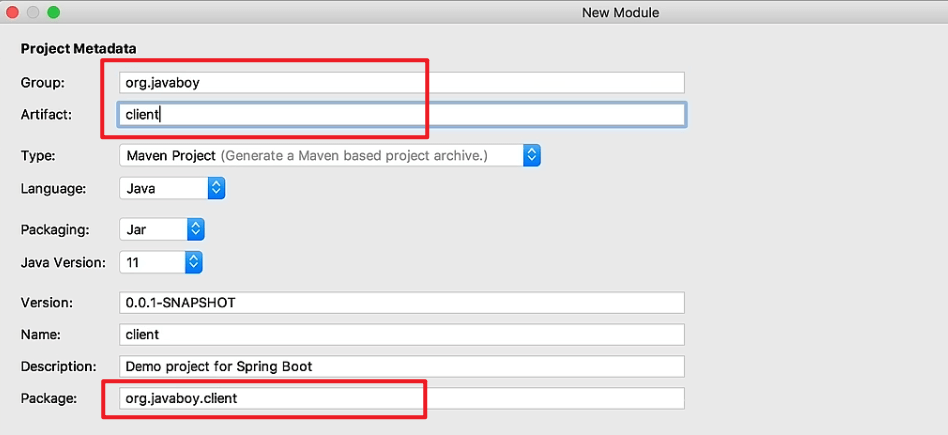说到 RPC(Remote Procedure Call Protocol 远程过程调用协议),小伙伴们脑海里蹦出的估计都是 RESTful API、Dubbo、WebService、Java RMI、CORBA 等。
其实,RabbitMQ 也给我们提供了 RPC 功能,并且使用起来很简单。
松哥通过一个简单的案例来和大家分享一下 Spring Boot+RabbitMQ 如何实现一个简单的 RPC 调用。
注意
关于 RabbitMQ 实现 RPC 调用,有的小伙伴可能会有一些误解,心想这还不简单?搞两个消息队列 queue_1 和 queue_2,首先客户端发送消息到 queue_1 上,服务端监听 queue_1 上的消息,收到之后进行处理;处理完成后,服务端发送消息到 queue_2 队列上,然后客户端监听 queue_2 队列上的消息,这样就知道服务端的处理结果了。
这种方式不是不可以,就是有点麻烦!RabbitMQ 中提供了现成的方案可以直接使用,非常方便。接下来我们就一起来学习下。
1. 架构
先来看一个简单的架构图:

这张图把问题说的很明白了:
- 首先 Client 发送一条消息,和普通的消息相比,这条消息多了两个关键内容:一个是 correlation_id,这个表示这条消息的唯一 id,还有一个内容是 reply_to,这个表示消息回复队列的名字。
- Server 从消息发送队列获取消息并处理相应的业务逻辑,处理完成后,将处理结果发送到 reply_to 指定的回调队列中。
- Client 从回调队列中读取消息,就可以知道消息的执行情况是什么样子了。
这种情况其实非常适合处理异步调用。
2. 实践
创建一个新的Empty Project,工程名叫做mq_rpc

在这个mq_rpc工程中用Spring Initializr的方式创建两个SpringBoot的module

创建一个模块,模块名叫做server

选择依赖

然后以同样的方法在mq_rpc工程中创建一个新的模块,模块名叫做client,勾选的依赖同上

在mq_rpc工程的client模块的application.properties配置文件中作如下的配置
spring.rabbitmq.host=localhostspring.rabbitmq.port=5672spring.rabbitmq.username=guestspring.rabbitmq.password=guestspring.rabbitmq.publisher-confirm-type=correlatedspring.rabbitmq.publisher-returns=true
这个配置前面四行都好理解,我就不赘述,后面两行:首先是配置消息确认方式,我们通过 correlated 来确认,只有开启了这个配置,将来的消息中才会带 correlation_id,只有通过 correlation_id 我们才能将发送的消息和返回值之间关联起来。最后一行配置则是开启发送失败退回。
在mq_rpc工程的client模块的org.javaboy.client.config包下面创建一个配置类
@Configurationpublic class RabbitConfig {public static final String RPC_MSG_QUEUE = "rpc_msg_queue";public static final String RPC_REPLY_MSG_QUEUE = "rpc_reply_msg_queue";public static final String RPC_EXCHANGE = "rpc_exchange";@BeanQueue msgQueue() {return new Queue(RPC_MSG_QUEUE);}@BeanQueue replyQueue() {return new Queue(RPC_REPLY_MSG_QUEUE);}@BeanTopicExchange topicExchange() {return new TopicExchange(RPC_EXCHANGE);}@BeanBinding msgBinding() {return BindingBuilder.bind(msgQueue()).to(topicExchange()).with(RPC_MSG_QUEUE);}@BeanBinding replyBinding() {return BindingBuilder.bind(replyQueue()).to(topicExchange()).with(RPC_REPLY_MSG_QUEUE);}/*** 使用 RabbitTemplate发送和接收消息* 并设置回调队列地址*/@BeanRabbitTemplate rabbitTemplate(ConnectionFactory connectionFactory) {RabbitTemplate rabbitTemplate = new RabbitTemplate(connectionFactory);rabbitTemplate.setReplyAddress(RPC_REPLY_MSG_QUEUE);rabbitTemplate.setReplyTimeout(6000);return rabbitTemplate;}/*** 给返回队列设置监听器*/@BeanSimpleMessageListenerContainer replyContainer(ConnectionFactory connectionFactory) {SimpleMessageListenerContainer simpleMessageListenerContainer = new SimpleMessageListenerContainer(connectionFactory);simpleMessageListenerContainer.setQueueNames(RPC_REPLY_MSG_QUEUE);simpleMessageListenerContainer.setMessageListener(rabbitTemplate(connectionFactory));return simpleMessageListenerContainer;}}
这个配置类中我们分别配置了消息发送队列 msgQueue 和消息返回队列 replyQueue,然后将这两个队列和交换机进行绑定。这个都是 RabbitMQ 的常规操作,没啥好说的。
在 Spring Boot 中我们负责消息发送的工具是 RabbitTemplate,默认情况下,系统自动提供了该工具,但是这里我们需要对该工具重新进行定制,主要是添加消息发送的返回队列,最后我们还需要给返回队列设置一个监听器。
在mq_rpc工程的client模块的org.javaboy.client.controller包下创建一个控制器
@RestControllerpublic class HelloController {@AutowiredRabbitTemplate rabbitTemplate;@GetMapping("/send")public void hello(String message) {//将来要发送的消息对象Message msg = MessageBuilder.withBody(message.getBytes()).build();//发送消息,方法的返回值就是 server 给出的响应Message result = rabbitTemplate.sendAndReceive(RabbitConfig.RPC_EXCHANGE, RabbitConfig.RPC_MSG_QUEUE, msg);if (result != null) {//发送的消息的 correlationIdString correlationId = msg.getMessageProperties().getCorrelationId();//返回的消息的 correlationIdString spring_returned_message_correlation = (String) result.getMessageProperties().getHeaders().get("spring_returned_message_correlation");if (correlationId.equals(spring_returned_message_correlation)) {System.out.println("收到服务端的响应:" + new String(result.getBody()));}}}}
这块的代码其实也都是一些常规代码,我挑几个关键的节点说下:
- 消息发送调用 sendAndReceive 方法,该方法自带返回值,返回值就是服务端返回的消息。
- 服务端返回的消息中,头信息中包含了 spring_returned_message_correlation 字段,这个就是消息发送时候的 correlation_id,通过消息发送时候的 correlation_id 以及返回消息头中的 spring_returned_message_correlation 字段值,我们就可以将返回的消息内容和发送的消息绑定到一起,确认出这个返回的内容就是针对这个发送的消息的。
这就是整个客户端的开发,其实最最核心的就是 sendAndReceive 方法的调用。调用虽然简单,但是准备工作还是要做足够。例如如果我们没有在 application.properties 中配置 correlated,发送的消息中就没有 correlation_id,这样就无法将返回的消息内容和发送的消息内容关联起来。
在mq_rpc工程的server模块的application.properties配置文件中作如下的配置
spring.rabbitmq.host=localhostspring.rabbitmq.port=5672spring.rabbitmq.username=guestspring.rabbitmq.password=guestspring.rabbitmq.publisher-confirm-type=correlatedspring.rabbitmq.publisher-returns=trueserver.port=8081
在mq_rpc工程的server模块的org.javaboy.client.config包下面创建一个配置类,这个配置类就比较简单,单纯的配置一下消息队列并将之和消息交换机绑定起来,如下:
@Configurationpublic class RabbitConfig {public static final String RPC_MSG_QUEUE = "rpc_msg_queue";public static final String RPC_REPLY_MSG_QUEUE = "rpc_reply_msg_queue";public static final String RPC_EXCHANGE = "rpc_exchange";@BeanQueue msgQueue() {return new Queue(RPC_MSG_QUEUE);}@BeanQueue replyQueue() {return new Queue(RPC_REPLY_MSG_QUEUE);}@BeanTopicExchange topicExchange() {return new TopicExchange(RPC_EXCHANGE);}@BeanBinding msgBinding() {return BindingBuilder.bind(msgQueue()).to(topicExchange()).with(RPC_MSG_QUEUE);}@BeanBinding replyBinding() {return BindingBuilder.bind(replyQueue()).to(topicExchange()).with(RPC_REPLY_MSG_QUEUE);}}
在mq_rpc工程的server模块的org.javaboy.client.controller包下创建一个控制器
@Componentpublic class RpcServer {@AutowiredRabbitTemplate rabbitTemplate;@RabbitListener(queues = RabbitConfig.RPC_MSG_QUEUE)public void process(Message message) {byte[] body = message.getBody();//这是服务端要返回的消息Message build = MessageBuilder.withBody(("我是服务端,我收到了客户端发来的:" + new String(body)).getBytes()).build();CorrelationData correlationData = new CorrelationData(message.getMessageProperties().getCorrelationId());rabbitTemplate.sendAndReceive(RabbitConfig.RPC_EXCHANGE, RabbitConfig.RPC_REPLY_MSG_QUEUE, build, correlationData);}}
这里的逻辑就比较简单了:
- 服务端首先收到消息并打印出来。
- 服务端提取出原消息中的 correlation_id。
- 服务端调用 sendAndReceive 方法,将消息发送给 rpc_reply_msg_queue队列,同时带上 correlation_id 参数。
服务端的消息发出后,客户端将收到服务端返回的结果。
启动两个服务,然后再浏览器访问:http://localhost:8080/send?message=江南一点雨,查看client应用的控制台


